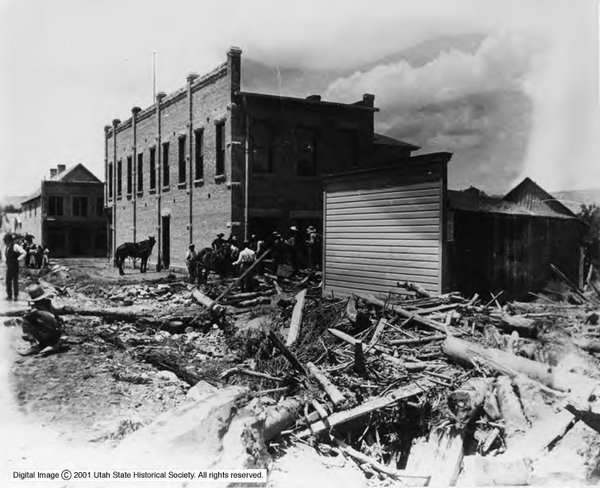Dublin Core
Title
Description
When you live in the desert, periodic floods come with the territory. But as Utahns learned around the turn of the twentieth century, what we do in the hills has a big impact in the valley.
By 1890, residents in Manti had begun to connect the worsening of floods to the overgrazing of their livestock in Manti Canyon. Overgrazed hills become more susceptible to erosion and less able to absorb rain and runoff. In 1900, mayoral candidate L.R. Anderson won his election by running on a “no more floods” platform. As mayor, Anderson successfully petitioned President Theodore Roosevelt to designate Manti Canyon as a national forest, leading Manti residents to limit their grazing. Their collective efforts paid off in 1909, when floods hit adjacent canyons while Manti Canyon went unaffected.
Some of the towns along the Wasatch Front were slower to learn the lessons of watershed management. In Logan and Cache Valleys, residents had harvested much of the mature timber, in addition to using those hills to graze large herds of sheep. Floodwaters ran rapidly down the denuded hills, easily overwhelming the dams and channels that the towns had built to try to control them. Meanwhile, their timber and grazing practices continued to damage watersheds.
Cultural attitudes and the economic benefits from unchecked grazing and logging made some Utahns reluctant to adopt more stringent watershed management practices. But in 1930 disastrous flooding hit Davis County. Utah State University professors and experts studied the floods and found that watershed conditions -- adversely affected by overgrazing and timber cutting -- was a major factor in these events.
In 1934, the US Congress passed the Taylor Grazing Act, establishing oversight over federal lands. By this time, Utahns had largely accepted the connection between flooding and watershed conditions. Officials began to reduce the number of cattle and sheep dramatically, and in this manner they mitigated their floods. Cities along the Wasatch finally learned what Manti had known for decades.
Creator
Source
Image: Debris from a 1902 flood litters the streets of Manti. Compared to other towns during the same era, Manti was relatively quick to connect the problem to watershed management. Courtesy Utah State Historical Society.
_______________
See Andrew M. Honker, “"Been Grazed Almost to Extinction": The Environment, Human Action, and Utah Flooding, 1900-1940,” Utah Historical Quarterly 67, no. 1 (1999); “Reduction of Manti National Forest Grazing Found Necessary,” Carbon County News, Dec 2, 1910; “Over-grazing largely responsible for floods,” Grand Valley Times, Oct 13, 1911.

